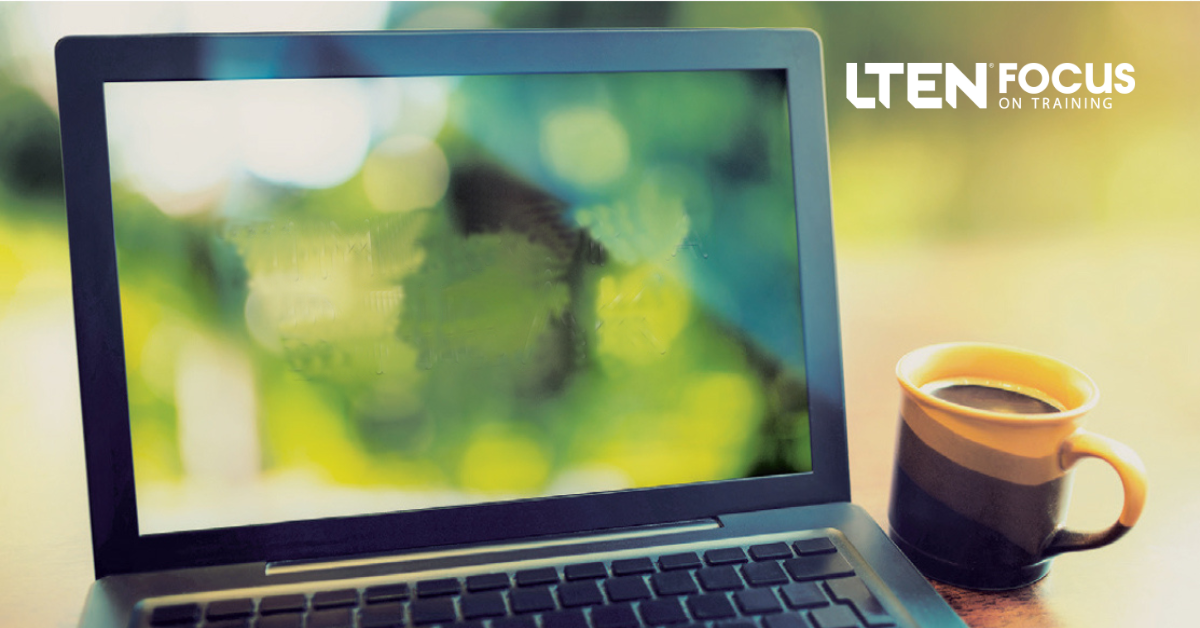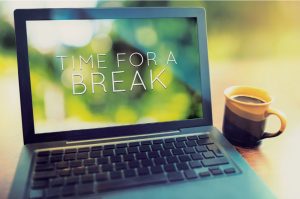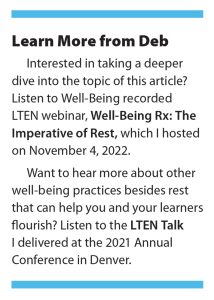
WORKING & LIVING WELL – Deborah Bonzell
Simply put, the way we’re working isn’t working
 Pausing to rest during a busy workday may feel like an act of laziness in our output obsessed culture, but it’s one of the most effective(and enjoyable) productivity hacks out there.
Pausing to rest during a busy workday may feel like an act of laziness in our output obsessed culture, but it’s one of the most effective(and enjoyable) productivity hacks out there.
How rested are you right now?
I’m writing this article in November 2022, but by the time you read this, it will be early 2023. You’ve successfully completed another year-end cycle at work, celebrated with colleagues, family and friends, and hopefully taken some much-earned vacation days.
And while many of these activities sound satisfying and enjoyable, let’s be honest— the holidays can also leave us feeling depleted and overstimulated. Which means we may be starting the new year off with less than a full tank of gas.
Can you relate?
Our Reluctance to Rest
Historically, winter has been the season of rest. The days grow shorter and darker, crops wither, trees lose their leaves. Animals become less active to conserve energy. Some even hibernate for months (oh, to be a sleeping bear).
 By contrast, we hustling humans have largely abandoned the practice of “wintering.” Instead, our always-on, tech-enabled society encourages us to stay in motion all day (and sometimes late into the night), all year long. I know I’m not the only one who feels that the pace of daily life has sped up exponentially over the past decade.
By contrast, we hustling humans have largely abandoned the practice of “wintering.” Instead, our always-on, tech-enabled society encourages us to stay in motion all day (and sometimes late into the night), all year long. I know I’m not the only one who feels that the pace of daily life has sped up exponentially over the past decade.
In the business realm, busyness can feel like an ill-fitting badge of honor, especially in those corporate cultures where “going above and beyond” is celebrated and rewarded. While the mission of helping patients is both compelling and laudable, chronically outsized effort (often directed by senior leaders) is taking an increasingly heavy toll on employees’ physical and mental health, mood and relationships.
As a result, more and more knowledge workers — including life sciences professionals — are becoming patients themselves. The diagnosis? Stress-related illness.
Simply put, the way we’re working isn’t working.
The Barriers to Rest
Recently, I asked a group of LTEN colleagues about the barriers/beliefs that get in the way of taking short rest breaks during the workday. Here is the list we considered together:
- Time (I’m too busy to rest.)
- Money (I can’t afford to rest.)
- Peer pressure (No one else seems to be resting, so I can’t either.)
- Redundancy (I already sleep at night, don’t I?)
- Physics (The law of inertia; if I stop, I may never get rolling again.)
- Work ethic (Rest is a sign of laziness or weakness.)
- Productivity (I demonstrate my value by completing activities.)
- Self-esteem (I feel worthy when I check things off my to-do list.)
- Emotions (I can avoid difficult feelings if I keep moving.)
The responses? Not surprisingly, perceived time scarcity (No. 1) was the top barrier mentioned, followed by beliefs about work ethic (No. 6) and a desire to avoid uncomfortable emotions (No. 9).
Based on my research, our LTEN group is far from alone in its reluctance to rest. Consider these stats:
- 35% of American adults regularly sleep less than the recommended seven hours per night, according to the CDC.
- This chronic sleep debt costs the U.S. economy as much as $411 billion annually in lost productivity annually in lost productivity.
- One in five workers in North America worry their boss won’t view them as hard working if they take regular lunch breaks.
- And, amazingly, there are exactly zero federal laws protecting meal and rest breaks for exempt workers in the United States.
Remembering to Pause
Reversing this “anti-rest” trend is daunting because many of the barriers and beliefs are systemic. And yet, each of us has the power to take small steps to normalize brief periods of rest as a necessary and productive use of time while on the job.
Here’s one of my favorite ways to practice rest while I’m in work mode. I find this exercise especially refreshing when I’ve been staring at a computer screen for awhile:
- First, close your eyes and take three slow, smooth deep breaths to relax your body and mind. Try to lengthen your exhale a beat or two with each successful breath.
- Next, tune into each of your five senses one by one, focusing your attention like a spotlight on the following parts of your body:
- Ears — Hear what you’re hearing.
- Nose — Smell what you’re smelling.
- Mouth — Taste what you’re tasting.
- Skin — Touch what you’re touching.
- Eyes — See what you’re seeing.
- Now, bring all five senses into focus at the same time to sense what you’re sensing. Resist the urge to mentally analyze the experience and allow yourself to feel whatever sensations and emotions arise.
This simple yet powerful exercise of “coming to your senses” switches off the conceptual mode of the brain, giving your thinking mind a much-needed break.
The Science of Rest
The evidence is undisputed — as humans, we need regular breaks from being in motion to relax, restore our energy and recover strength. Sports professionals and coaches have long integrated rest periods into their training regimens. As corporate athletes, it’s time we follow their lead and reap the many benefits of on-the-job rest, which include:
- Facilitates the regulation of heart rate and respiration.
- Supports digestion, detoxification and cellular repair.
- Promotes calm and well-being through the release of the hormone serotonin.
- Enhances decision-making confidence and task performance.
- Boosts learning by strengthening and consolidating memories.
Resting While Learning
Did you catch that last bullet point? Rest boosts learning. Period. That means we all need to do more than give our participants bio and lunch breaks; we need to embed opportunities to rest into our learning activities.
Here are six ways my team and I practice rest as part of our interval-style well workouts:
- Conscious breathing — Diaphragmatic breathing with an emphasis on lengthening the exhale is the most fundamental of all restorative exercises.
- Mindfulness — “Tuning in” to our present-moment experiences, such as thoughts, the breath, sounds or other sensations, helps calm the mind.
- Mind wandering — Conversely, “tuning out” by intentionally letting the mind wander also helps alleviate cognitive stress while stimulating creativity.
- Restorative poses — Yoga postures such as mountain and corpse pose, seated forward folds and inversions send a signal of safety to our nervous system.
- Music — Listening to songs that use sound therapy principles can stimulate the relaxation response.
- Silence — Taking a deliberate break from speaking, noise and interaction.
To add to this list, here are some road-tested ideas from LTEN colleagues, some of which involve more active (yet still refreshing) forms of rest:
- Go outside.
- Take a walk (preferably in nature).
- Do a quick exercise or stretch.
- Meditate using a mantra.
- Inject humor.
Imagine sprinkling a few of these restorative practices into your workday — after completing a challenging task, at the start of an important meeting, in the middle of a complex training session. How might having brief but regular periods to relax and recover your strength impact your motivation? Your productivity? Your overall experience as a working professional?
Here’s the bottom line: Like the other simple, science-based practices I’ve written about for LTEN, rest is medicine. And lucky for us, we have the power to dispense it — to ourselves, learners, colleagues and anyone else whose well-being matters to us. No prescription needed.
Endings and Beginnings
As I contemplate the end of both this article and our year-long Wellbeing Rx webinar series, I’m grateful to everyone in the LTEN community who has engaged with these ideas and practices in some way.
It is my sincere hope that company cultures — particularly in the life sciences —are slowly evolving in positive ways that more fully honor our basic human needs. This includes the need to balance our daily work effort by periodically pausing to rest, to breathe and just be. Because as author Alex Soojung-Kim Pang stated in his 2018 book, Rest: Why You Get More Done When You Work Less:
“Rest is not work’s adversary. Rest is work’s partner.”
Here’s to a new year and new ways of working that support the health and well-being not just of patients, but of employees, too. Onward — let’s be well together!
 Deborah Bonzell is a former life sciences trainer and the founder of The Well Workout. Email Deb at deb@thewellworkout.com.
Deborah Bonzell is a former life sciences trainer and the founder of The Well Workout. Email Deb at deb@thewellworkout.com.








